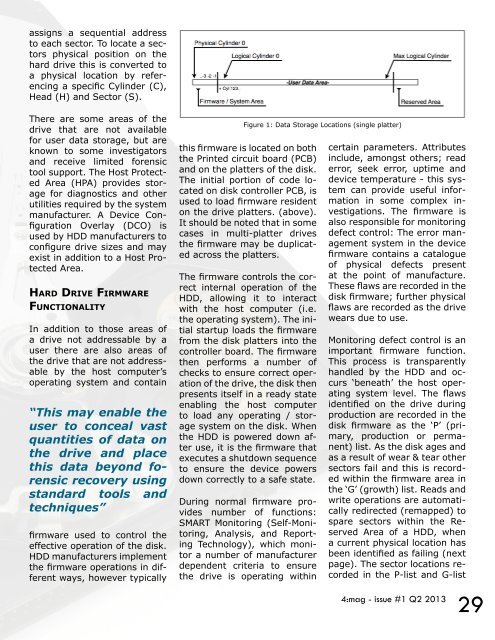You also want an ePaper? Increase the reach of your titles
YUMPU automatically turns print PDFs into web optimized ePapers that Google loves.
assigns a sequential address<br />
to each sector. To locate a sectors<br />
physical position on the<br />
hard drive this is converted to<br />
a physical location by referencing<br />
a specific Cylinder (C),<br />
Head (H) and Sector (S).<br />
There are some areas of the<br />
drive that are not available<br />
for user data storage, but are<br />
known to some investigators<br />
and receive limited forensic<br />
tool support. The Host Protected<br />
Area (HPA) provides storage<br />
for diagnostics and other<br />
utilities required by the system<br />
manufacturer. A Device Configuration<br />
Overlay (DCO) is<br />
used by HDD manufacturers to<br />
configure drive sizes and may<br />
exist in addition to a Host Protected<br />
Area.<br />
hArd drive FirMwAre<br />
FunctionAlity<br />
In addition to those areas of<br />
a drive not addressable by a<br />
user there are also areas of<br />
the drive that are not addressable<br />
by the host computer’s<br />
operating system and contain<br />
“This may enable the<br />
user to conceal vast<br />
quantities of data on<br />
the drive and place<br />
this data beyond forensic<br />
recovery using<br />
standard tools and<br />
techniques”<br />
firmware used to control the<br />
effective operation of the disk.<br />
HDD manufacturers implement<br />
the firmware operations in different<br />
ways, however typically<br />
Figure 1: Data Storage Locations (single platter)<br />
this firmware is located on both<br />
the Printed circuit board (PCB)<br />
and on the platters of the disk.<br />
The initial portion of code located<br />
on disk controller PCB, is<br />
used to load firmware resident<br />
on the drive platters. (above).<br />
It should be noted that in some<br />
cases in multi-platter drives<br />
the firmware may be duplicated<br />
across the platters.<br />
The firmware controls the correct<br />
internal operation of the<br />
HDD, allowing it to interact<br />
with the host computer (i.e.<br />
the operating system). The initial<br />
startup loads the firmware<br />
from the disk platters into the<br />
controller board. The firmware<br />
then performs a number of<br />
checks to ensure correct operation<br />
of the drive, the disk then<br />
presents itself in a ready state<br />
enabling the host computer<br />
to load any operating / storage<br />
system on the disk. When<br />
the HDD is powered down after<br />
use, it is the firmware that<br />
executes a shutdown sequence<br />
to ensure the device powers<br />
down correctly to a safe state.<br />
During normal firmware provides<br />
number of functions:<br />
SMART Monitoring (Self-Monitoring,<br />
Analysis, and Reporting<br />
Technology), which monitor<br />
a number of manufacturer<br />
dependent criteria to ensure<br />
the drive is operating within<br />
certain parameters. Attributes<br />
include, amongst others; read<br />
error, seek error, uptime and<br />
device temperature - this system<br />
can provide useful information<br />
in some complex investigations.<br />
The firmware is<br />
also responsible for monitoring<br />
defect control: The error management<br />
system in the device<br />
firmware contains a catalogue<br />
of physical defects present<br />
at the point of manufacture.<br />
These flaws are recorded in the<br />
disk firmware; further physical<br />
flaws are recorded as the drive<br />
wears due to use.<br />
Monitoring defect control is an<br />
important firmware function.<br />
This process is transparently<br />
handled by the HDD and occurs<br />
‘beneath’ the host operating<br />
system level. The flaws<br />
identified on the drive during<br />
production are recorded in the<br />
disk firmware as the ‘P’ (primary,<br />
production or permanent)<br />
list. As the disk ages and<br />
as a result of wear & tear other<br />
sectors fail and this is recorded<br />
within the firmware area in<br />
the ‘G’ (growth) list. Reads and<br />
write operations are automatically<br />
redirected (remapped) to<br />
spare sectors within the Reserved<br />
Area of a HDD, when<br />
a current physical location has<br />
been identified as failing (next<br />
page). The sector locations recorded<br />
in the P-list and G-list<br />
4:<strong>mag</strong> - issue <strong>#1</strong> <strong>Q2</strong> <strong>2013</strong><br />
29




